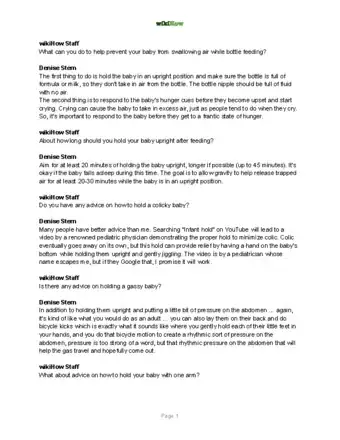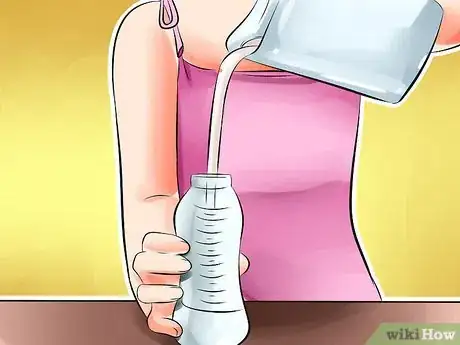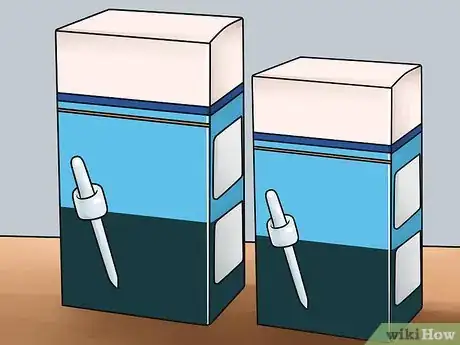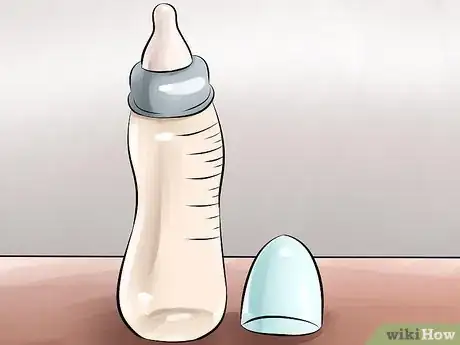This article was co-authored by Denise Stern. Denise Stern is a Parenting Specialist and the CEO of Let Mommy Sleep, the country’s leading Baby Nurse and Postpartum Care service. Denise specializes in providing nurturing care to newborns and evidence-based education to their parents. She holds a BA in Public Relations from North Carolina State University. Denise was the US Chamber of Commerce Leading Woman-Owned Business in 2013, a Washington FAMILY Magazine Mother of the Year in 2016, and on the elite White House Summit for Working Families hosted by the President and First Lady Obama in 2014. Let Mommy Sleep is the only company of its kind that holds a local government contract to teach newborn and postpartum care.
This article has been viewed 118,657 times.
When you feed your baby from a bottle, you run the risk of your baby swallowing air along with her milk or formula. This air can cause your baby to have an upset tummy and become gassy. Because of this, it is important to try to minimize the amount of air in your baby’s bottle.
Steps
Pouring the Milk to Combat Air Bubbles
-
1Prepare the formula or milk in advance. Mix the milk or formula in a separate bowl or cup. When you prepare the formula in the bottle, there is an increased chance that air bubbles will form.[1]
- Make sure to stir the formula slowly so that you minimize the number of air bubbles that form.
-
2Avoid pouring the milk from high above the bottle. Instead, get the bowl or cup as close to the lip of the bottle as possible, and slowly pour the formula into the bottle. If you pour the formula out of the cup and into the bottle from a great height, the formula will hit the bottom of the bottle and form bubbles.
- Pouring the formula slowly also helps to make sure that the liquid does not trap air as it gets poured into the bottle.
Advertisement -
3Avoid shaking the bottle. If you must prepare the formula in the bottle, stir the formula rather than shaking the bottle. When you shake the bottle, or handle the bottle roughly, air bubbles are more likely to form.
- Stir the formula with a wooden stick or knife to make sure that it is mixed in well.
-
4Allow the bottle time to stand before you give in to your baby. Try to prepare the formula at least five to ten minutes before your baby’s normal feeding time. Letting the bottle sit once you have poured the formula into it will help any lingering bubbles to settle and disperse.[2]
- Preparing your baby’s formula ahead of time will keep you from rushing through the preparation process. When you rush, you are more likely to stir the formula quickly, which causes bubbles to form.
-
5Consider using drops that will reduce the amount of air bubbles that form in your formula. Talk to your pediatrician about what products you should use and how many drops you should add to the bottle. In addition to this, it is always important to read the instructions that come with the drops.[3]
- “Mylicon” drops are commonly used for this purpose.These drops contain simethicone, an ingredient that helps the breakdown of gases and air bubbles, and is not harmful for babies.
- “Tummy calm” is a homeopathic medicine that prevents gases with the help of natural ingredients like chamomile, thuja, and silicea.
- Gas drops can be expensive, and some studies suggest that they may not be very effective. However, they appear to be safe, so they shouldn't harm your baby if you do decide to try them.[4]
-
6Use bottles that can only contain enough milk for one whole feeding. If you are able to fill the bottle up all the way, there will be less room for air bubbles to form.
- Always make sure that the bottle is full of formula or milk so the baby is not taking any air from the bottle. Even the bottle nipple should be full of fluid and no air.
Holding the Baby and Making Sure the Bottle Works
-
1Keep your baby’s head elevated. Hold your baby so that she is in a half lying position, with her head slightly elevated.[5] This position will help your baby to swallow and breathe, while gravity will help to bring the milk or formula down into your baby’s tummy.
-
2Position the bottle correctly. Hold the bottle so that it is in a horizontal position, parallel to the floor. Tilt the bottle when you feed your baby, so that the milk fills the entire nipple, and there is no room left for air.[6]
- Generally, you want to aim for a 45 degree angle, but this will change depending on how much milk is in the bottle.
-
3Check to see how well the milk is flowing. If the milk flows continuously, your baby will be less likely to swallow air. To check to see how the milk is flowing:[7]
- Fill the bottle up with milk or water. Turn the bottle upside down. The flow should be approximately one drop of liquid every second.
- You should get a new bottle if the liquid stops and starts flowing constantly. This will cause your baby to struggle to suck out the liquid.
- If the liquid flows without stop out of the bottle, there is a chance that your baby will not be able to catch her breath. This is also a problem.
-
4Check to make sure that the ring at the neck of the bottle is properly tightened. The ring will allow air circulation into the bottle, to make it easier for your child to suck out the milk or formula. If your child is having a hard time getting milk, but the nipple appears to be working well, check to see that the ring is tightened on to the bottle properly.
- The ring may need to be loosened a little bit in order to allow your baby to suck out the milk.
- The ring is tight enough when you can see a large bubble forming every time your baby takes a drink. If it is not on properly, you will see a bunch of bubbles form as soon as your baby stops trying to suck the milk out of the bottle.
Choosing the Right Bottle
-
1Use angled bottles. An angled or sloped bottle helps to keep the milk at the top of the bottle, where the nipple is, even when your baby moves the bottle around. This keeps the nipple full at all times.[8]
-
2Try a bottle with a one-way valve. These bottles are specially designed so that air cannot reach the milk. The nipple is separated from the bottle by a one-way valve.
- Use a bottle with a valve at the top. This valve allows just enough air to enter the bottle so that your baby can drink easily, without consuming any air bubbles.
-
3Try a bottle that has a straw vent. In this case, the straw is not actually used for drinking. Instead, the straw acts like a vent, so it makes it easier for your baby to drink out of the bottle without drinking any air bubbles.
Expert Q&A
-
QuestionHow long should you hold your baby upright after feeding?
 Denise SternDenise Stern is a Parenting Specialist and the CEO of Let Mommy Sleep, the country’s leading Baby Nurse and Postpartum Care service. Denise specializes in providing nurturing care to newborns and evidence-based education to their parents. She holds a BA in Public Relations from North Carolina State University. Denise was the US Chamber of Commerce Leading Woman-Owned Business in 2013, a Washington FAMILY Magazine Mother of the Year in 2016, and on the elite White House Summit for Working Families hosted by the President and First Lady Obama in 2014. Let Mommy Sleep is the only company of its kind that holds a local government contract to teach newborn and postpartum care.
Denise SternDenise Stern is a Parenting Specialist and the CEO of Let Mommy Sleep, the country’s leading Baby Nurse and Postpartum Care service. Denise specializes in providing nurturing care to newborns and evidence-based education to their parents. She holds a BA in Public Relations from North Carolina State University. Denise was the US Chamber of Commerce Leading Woman-Owned Business in 2013, a Washington FAMILY Magazine Mother of the Year in 2016, and on the elite White House Summit for Working Families hosted by the President and First Lady Obama in 2014. Let Mommy Sleep is the only company of its kind that holds a local government contract to teach newborn and postpartum care.
Parenting Specialist Hold them upright for a minimum of 20 minutes, but if you can do it for closer to 30-45 minutes, that's even better. They might fall asleep, but that's okay—the air can still come up. When they're upright, gravity is at work for them.
Hold them upright for a minimum of 20 minutes, but if you can do it for closer to 30-45 minutes, that's even better. They might fall asleep, but that's okay—the air can still come up. When they're upright, gravity is at work for them. -
QuestionHow can I relieve my baby's gas fast?
 Denise SternDenise Stern is a Parenting Specialist and the CEO of Let Mommy Sleep, the country’s leading Baby Nurse and Postpartum Care service. Denise specializes in providing nurturing care to newborns and evidence-based education to their parents. She holds a BA in Public Relations from North Carolina State University. Denise was the US Chamber of Commerce Leading Woman-Owned Business in 2013, a Washington FAMILY Magazine Mother of the Year in 2016, and on the elite White House Summit for Working Families hosted by the President and First Lady Obama in 2014. Let Mommy Sleep is the only company of its kind that holds a local government contract to teach newborn and postpartum care.
Denise SternDenise Stern is a Parenting Specialist and the CEO of Let Mommy Sleep, the country’s leading Baby Nurse and Postpartum Care service. Denise specializes in providing nurturing care to newborns and evidence-based education to their parents. She holds a BA in Public Relations from North Carolina State University. Denise was the US Chamber of Commerce Leading Woman-Owned Business in 2013, a Washington FAMILY Magazine Mother of the Year in 2016, and on the elite White House Summit for Working Families hosted by the President and First Lady Obama in 2014. Let Mommy Sleep is the only company of its kind that holds a local government contract to teach newborn and postpartum care.
Parenting Specialist In addition to holding them upright and putting a little bit of pressure on their abdomen, you can also lay them on their back and do bicycle kicks, which is exactly what it sounds like. You gently hold each of their little feet in your hands and you do that bicycle motion to create a rhythmic sort of pressure on the abdomen. This helps the gas travel and hopefully come out.
In addition to holding them upright and putting a little bit of pressure on their abdomen, you can also lay them on their back and do bicycle kicks, which is exactly what it sounds like. You gently hold each of their little feet in your hands and you do that bicycle motion to create a rhythmic sort of pressure on the abdomen. This helps the gas travel and hopefully come out.
Expert Interview

Thanks for reading our article! If you'd like to learn more about bottle feeding, check out our in-depth interview with Denise Stern.
References
- ↑ https://living.thebump.com/air-bubbles-out-infants-bottle-6404.html
- ↑ https://living.thebump.com/air-bubbles-out-infants-bottle-6404.html
- ↑ https://www.healthychildren.org/English/ages-stages/baby/diapers-clothing/Pages/Breaking-Up-Gas.aspx
- ↑ https://www.healthychildren.org/English/ages-stages/baby/diapers-clothing/Pages/Breaking-Up-Gas.aspx
- ↑ https://raisingchildren.net.au/newborns/breastfeeding-bottle-feeding/bottle-feeding/giving-the-bottle
- ↑ http://nurturedchild.ca/index.php/2010/12/10/baby-led-bottle-feeding/
- ↑ https://living.thebump.com/test-flow-bottle-nipples-13737.html
- ↑ https://living.thebump.com/air-bubbles-out-infants-bottle-6404.html
About This Article
If you feed your baby from a bottle, you’ll want to keep air out of it so your baby doesn’t become gassy. Mix the milk or formula in a separate bowl or cup to decrease the risk of air bubbles forming. Once the milk or formula is ready, get the bowl or cup as close to the lip of the bottle as possible and slowly pour it in to keep bubbles at a minimum. If you have to prepare the formula in the bottle, stir it rather than shake the bottle so fewer air bubbles form. Let the bottle stand for 5 to 10 minutes before giving it to your baby to help it settle. When it’s time to feed your baby, hold the bottle so it’s horizontal and parallel to the floor so the milk fills the entire nipple. To learn how to choose the right bottle to minimize air getting into your baby’s tummy, keep reading!









































































